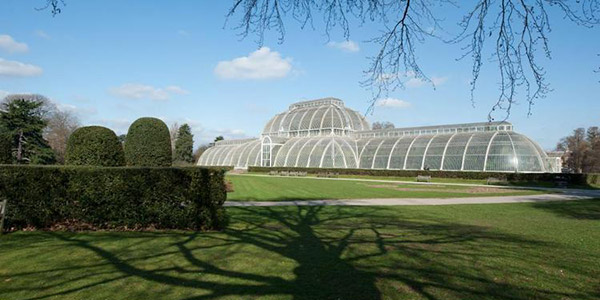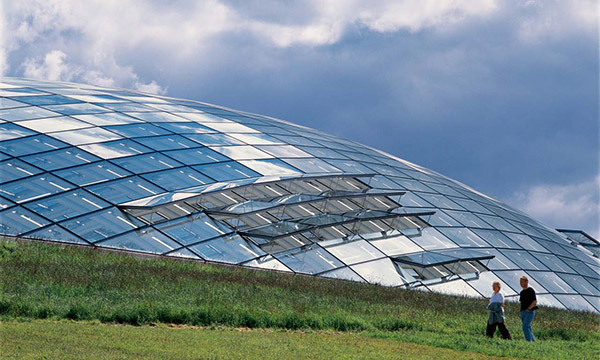A look at metalwork and glass structures from Victorian times to the present day…
The great glass houses of Britain are part building, part sculpture and part nursery – iron, steel and glass structures nurturing rare species of plants and trees from a wide variety of regions and climates. The construction materials may have changed over the past 150 years, or so, but the architectural aims and challenges seem to have remained similar.
So what is the main aim in the design and structure of a glasshouse of epic proportions? Scale, first and foremost, in terms of the height and span of roof and the need to avoid the encumbrance of supporting pillars. Heating and ventilation systems, as with any glasshouse, are essential features and this is the one area where, perhaps, technological change is the most evident. Even more challenging is the requirement for a structure to be in visual harmony with the rare species of plants and trees housed within it.
The era of the great glasshouse began with the Palm House at Kew Gardens which was built between the years 1844 and 1848 and is, to this day, considered to be the world’s most important example of large-scale structural use of wrought iron. The thing that makes the Palm House particularly remarkable is its vast spans of wrought-iron and glass that have a delicacy and intricacy you wouldn’t associate with a building that spans 110 metres in length. It was designed by Decimus Burton, commissioned by the botanist and director of Kew, Sir William Hooke, and built by Richard Turner, an engineer from a Dublin-based ironworks.
The architect’s outline plan was for a glass and cast iron structure. When Sir William Hooker showed interest, Turner suggested wrought iron for the roof-arch ribs – a change to the original specification. Hence the Palm House at Kew became the first architectural building to use newly-patented, rolled-wrought-iron beams, originally designed for ship building. Some say the structure has the look of a huge, inverted hull; others say its intricacy and repeated detail sympathetically reflect the lightness and delicacy of the trees and plants that are propagated within it.

The Palm House, Kew Gardens
The Temperate House at Kew Gardens, which is currently under renovation, followed later in the 19th century and, at 191 metres in length, is almost twice the size of the Palm House. It was also designed by the architect, Decimus Burton, and features many fine examples of Victorian metalwork, including decorative trusses and iron-capped pilasters. It is epitomised by its ornate spiral stairs which, in spite of their cast-iron structure, have an intricate delicacy that hints visually at the swirling ferns around them.
In the modern era, the nearest that comes to these classic Victorian structures, in terms of size and ambition, is the Great Glasshouse at the Botanical Gardens of Wales, designed by architects, Norman Foster & Partners . It is the world’s largest single-span glasshouse measuring 110 metres long x 60 metres wide. The dome itself comprises 785 double-glazed panes of glass, each of which has a laminated film sandwiched in the middle. Steel ball-and-socket joints attach 24 tubular arches to a concrete plinth and special joints allow for expansion of the steel ribs which cover the glasshouse. Ventilation and temperature control are provided by a combination of a biomass furnace and 147 computer-controlled vents.

The Great Glasshouse, Botanical Gardens of Wales
The design has been compared to a giant dewdrop and, like the Prince of Wales Conservatory at Kew, which was built in 1985, its walls are below ground, providing thermal efficiencies in terms of heat retention as well as providing a powerful symbol of integrating what is man-made and imposed, on the one hand, with the natural, incontrovertible contours of the land, on the other.
Much has changed in terms of the materials available to the builders of a modern-day structure such as the Giant Glasshouse or the Prince of Wales Conservatory as compared with their Victorian predecessors. The glass can now be double-glazed and thermally efficient. The steel used for the building’s skeleton can be tubular, providing strength and flexibility to a vast superstructure. Joints have the facility to expand. Ventilation can be fully computer controlled.
However, in spite of all these advances in terms of building technology, there remain clear parallels between the purpose and innate character of the classic Victorian glasshouses of Kew in London and their modern equivalent at the Botanical Gardens of Wales in Carmarthenshire. Both the old and new remain as places to preserve and propagate rare plants and trees, and to increase knowledge. Both continue to provide a unique and harmonious space, somehow removed from the mundaneness of the everyday, in which visitors can both learn and enjoy themselves.